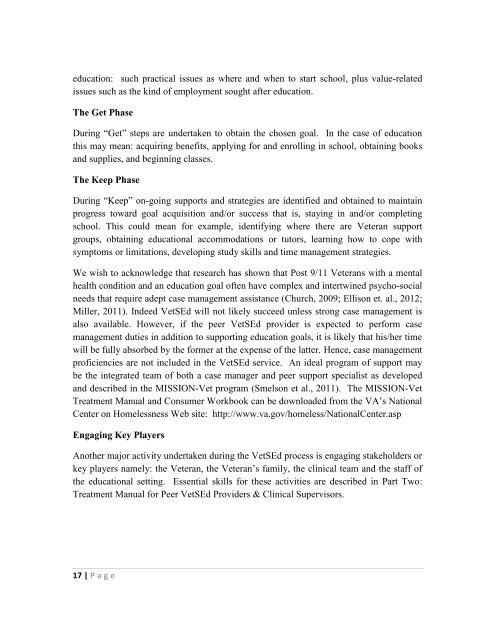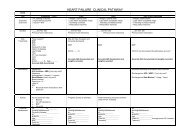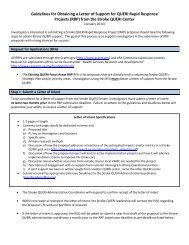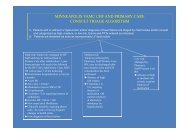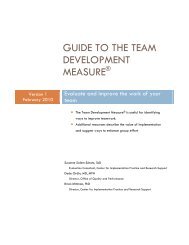The Veteran Supported Education Service Treatment Manual: VetSEd
The Veteran Supported Education Service Treatment Manual: VetSEd
The Veteran Supported Education Service Treatment Manual: VetSEd
You also want an ePaper? Increase the reach of your titles
YUMPU automatically turns print PDFs into web optimized ePapers that Google loves.
education: such practical issues as where and when to start school, plus value-related<br />
issues such as the kind of employment sought after education.<br />
<strong>The</strong> Get Phase<br />
During ―Get‖ steps are undertaken to obtain the chosen goal. In the case of education<br />
this may mean: acquiring benefits, applying for and enrolling in school, obtaining books<br />
and supplies, and beginning classes.<br />
<strong>The</strong> Keep Phase<br />
During ―Keep‖ on-going supports and strategies are identified and obtained to maintain<br />
progress toward goal acquisition and/or success that is, staying in and/or completing<br />
school. This could mean for example, identifying where there are <strong>Veteran</strong> support<br />
groups, obtaining educational accommodations or tutors, learning how to cope with<br />
symptoms or limitations, developing study skills and time management strategies.<br />
We wish to acknowledge that research has shown that Post 9/11 <strong>Veteran</strong>s with a mental<br />
health condition and an education goal often have complex and intertwined psycho-social<br />
needs that require adept case management assistance (Church, 2009; Ellison et. al., 2012;<br />
Miller, 2011). Indeed <strong>VetSEd</strong> will not likely succeed unless strong case management is<br />
also available. However, if the peer <strong>VetSEd</strong> provider is expected to perform case<br />
management duties in addition to supporting education goals, it is likely that his/her time<br />
will be fully absorbed by the former at the expense of the latter. Hence, case management<br />
proficiencies are not included in the <strong>VetSEd</strong> service. An ideal program of support may<br />
be the integrated team of both a case manager and peer support specialist as developed<br />
and described in the MISSION-Vet program (Smelson et al., 2011). <strong>The</strong> MISSION-Vet<br />
<strong>Treatment</strong> <strong>Manual</strong> and Consumer Workbook can be downloaded from the VA‘s National<br />
Center on Homelessness Web site: http://www.va.gov/homeless/NationalCenter.asp<br />
Engaging Key Players<br />
Another major activity undertaken during the <strong>VetSEd</strong> process is engaging stakeholders or<br />
key players namely: the <strong>Veteran</strong>, the <strong>Veteran</strong>‘s family, the clinical team and the staff of<br />
the educational setting. Essential skills for these activities are described in Part Two:<br />
<strong>Treatment</strong> <strong>Manual</strong> for Peer <strong>VetSEd</strong> Providers & Clinical Supervisors.<br />
17 | P a g e


